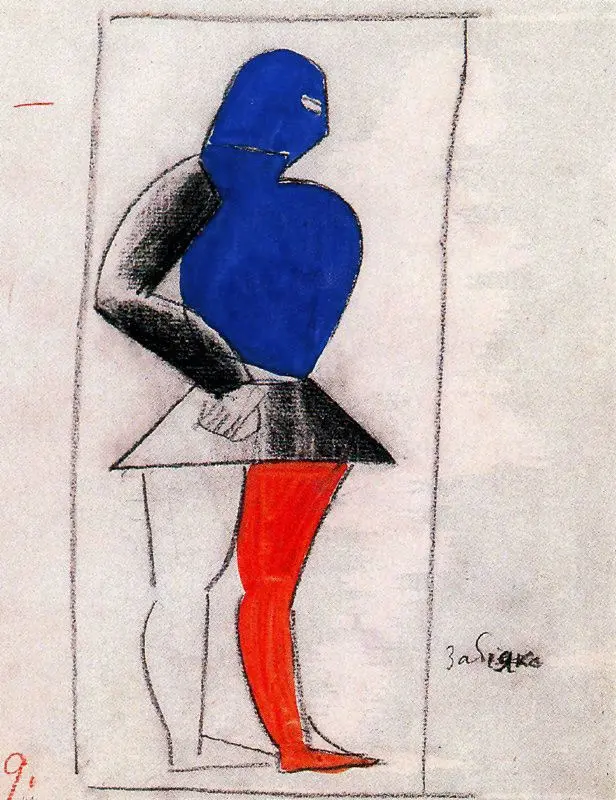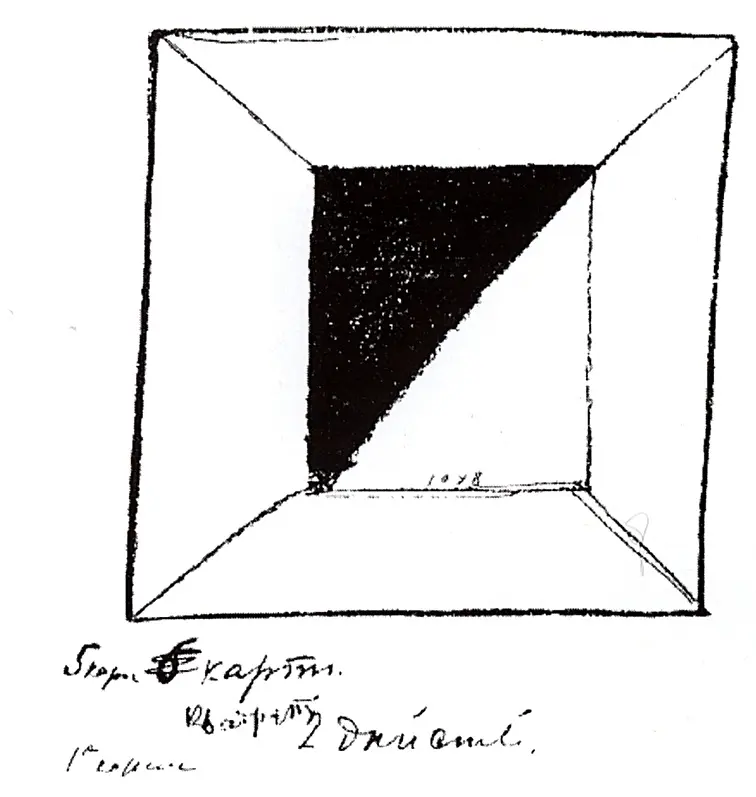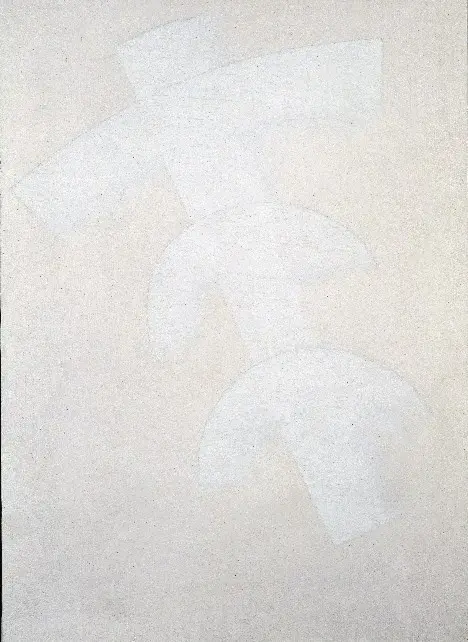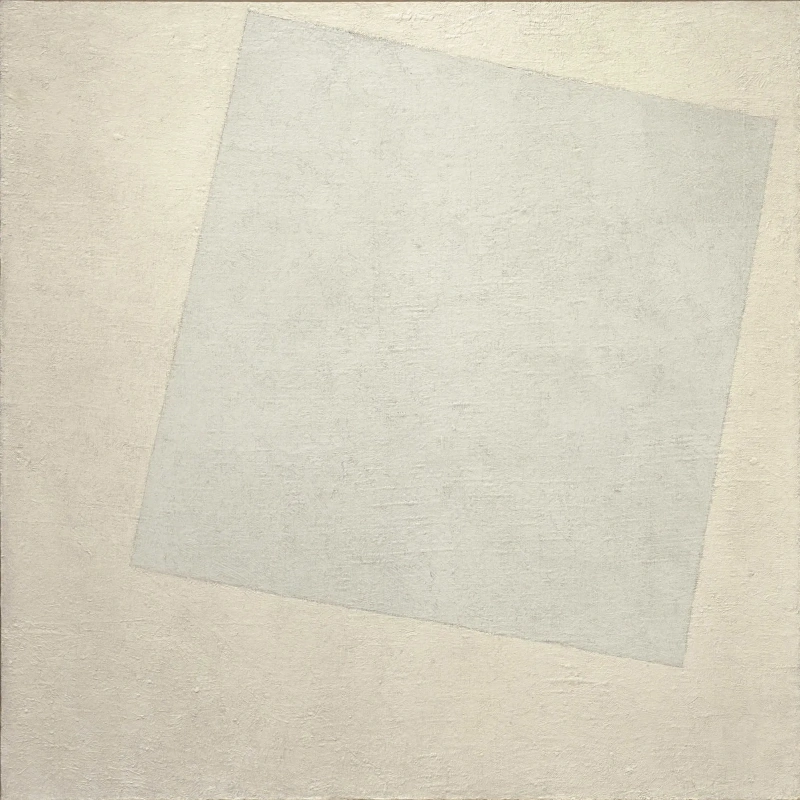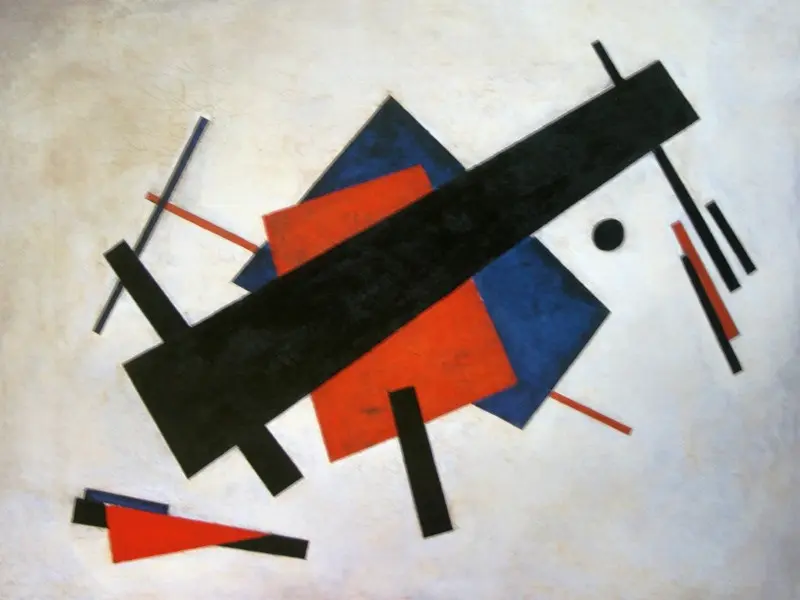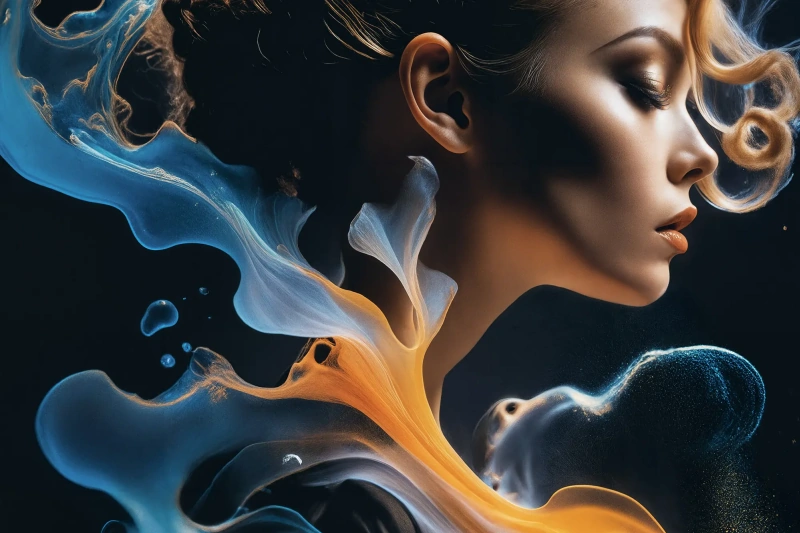Suprematism was one of the most influential trends in abstract art of the twentieth century. It rendered the structure of the universe in simple geometric forms, like a straight line, a rectangle, a circle, a square on a light background, signifying the infinity of space. The ideas of Suprematism, with its countdown marked by the famous Black Square, were embodied in the architecture, scenography, graphic arts, and industrial design.

Unlike many "isms", the titles for which were invented post factum by art historians, Suprematism owes its birth, existence, development, theoretical justification, "promotion to the masses," and even speculative-space perspectives to a single person, Kazimir Malevich (1879−1935).
"Suprematism establishes connections with the Earth, but due to its economic structures it changes the whole architecture of the material on the Earth, it joins the space of moving masses of the planetary system".
Kazimir Malevich
Malevich was not a natural-born suprematist. The artist’s way was winding and full of experiments. In the beginning of the century, Malevich flirted with Impressionism, it was in 1910s; in his "peasant works" he experimented with neo-primitivism; in his "Bather" or "Polishers" dated 1911 Malevich was clearly captivated by "The Dance" of Matisse, and in 1913 he painted cubist paintings (1, 2) in the spirit of Braque and Picasso. Then he started his futurist experiments from testing "abstruse realism" . It turned out that he was only approaching the main thing.
Suprematism will become Malevich`s magnum opus, his obsession, or his Love Supreme, as the modern pop hit goes.
Suprematism will become Malevich`s magnum opus, his obsession, or his Love Supreme, as the modern pop hit goes.
Fascination with the Fauves, experienced not only by Malevich, but also by many of his colleagues, began with the Russian-French exhibition "The Golden Fleece" held in 1908; Malevich and Chagall could have seen the famous "Dance" by Henri Matisse in the collection of the art patron Sergei Shchukin. For Malevich, flatness, lack of perspective and bright colors became a stepping stone to the final fleet from the material world into Suprematism.
False start of Suprematism: futuristic opera "Victory over the Sun"
In 1913, the word "Suprematism" was still unnamed and not even found, though all the prerequisites had already existed at that time.At this period, Malevich was close to the futurists, who proclaimed their all-Russian congress in July 1913. Despite a loud name, the chamber event was held in the country house of the composer and painter Mikhail Matyushin, in the Finnish village of Uusikirkko, and the participants were limited to three of them: Mikhail Matiushin, Aleksei Kruchenykh, and Kazimir Malevich.
The delegates called themselves "budetlyane" and, like all self-respecting avant-gardists, they immediately adopted the Manifesto on how they would convert useless and outdated art. One of the goals, for example, was stated as follows, "to head at a stronghold of artistic feebleness, Russian theater, and to convert it radically".

The first all-Russian congress of futurists. From left to right: Mikhail Matyushin, Kazimir Malevich and Alexey Kruchenykh.
Uusikirkko, Finland, at the country house of Matiushin on July 18, 1913
Uusikirkko, Finland, at the country house of Matiushin on July 18, 1913
They acted decisively starting with the creation of the opera "Victory over the Sun," which was entirely based on the principles of illogic. Matyushin composed dissonant music, Kruchenykh wrote the libretto with brand futuristic nonsense, Malevich invented the sets and costumes, which would later become the impetus for the birth of Suprematism. The premiere of "Victory over the Sun" took place in 1913.
Four years later, Malevich would recall with the expression typical of him, "Matiushin`s sound was destroying the bark of the old music sounds stuck and greased with applause; Kruchenykh`s words, letters and sounds were spraying the material word. The veil was torn, simultaneously tearing the scream of consciousness of the old brain, revealing to the eyes of a wild crowd the roads, sticking both to the ground and to the sky."
This performance has not been staged for 70 years, during its premiere the frustrated audience was leaving the venue. Nevertheless, it had a lot of quite revolutionary discoveries. The music by Mikhail Matyushin, for example, included the sounds of street noises, the honking of passing cars. The nonsense by Kruchenykh and Khlebnikov, who wrote the prologue for the Opera, also found its readers. In fact, Suprematism, the art which tried hard to escape from natural forms in the direction of geometric abstraction, was born there. Malevich decorated the curtain with the half black square on a white background.
Four years later, Malevich would recall with the expression typical of him, "Matiushin`s sound was destroying the bark of the old music sounds stuck and greased with applause; Kruchenykh`s words, letters and sounds were spraying the material word. The veil was torn, simultaneously tearing the scream of consciousness of the old brain, revealing to the eyes of a wild crowd the roads, sticking both to the ground and to the sky."
This performance has not been staged for 70 years, during its premiere the frustrated audience was leaving the venue. Nevertheless, it had a lot of quite revolutionary discoveries. The music by Mikhail Matyushin, for example, included the sounds of street noises, the honking of passing cars. The nonsense by Kruchenykh and Khlebnikov, who wrote the prologue for the Opera, also found its readers. In fact, Suprematism, the art which tried hard to escape from natural forms in the direction of geometric abstraction, was born there. Malevich decorated the curtain with the half black square on a white background.
See the costumes of the actors of "Victory over the Sun" opera designed by Kazimir Malevich:
In the sketches of "Victory over the Sun" scenery by Kazimir Malevich the black square appeared as an alternative to the solar circle. In those sketches dated 1913, the black square started to displace all the objects of the visible world, but it still had not started to absorb all the material forms.

Реконструкция оперы "Победа над Солнцем" в Театре Стаса Намина. Сценография Казимира Малевича. Фото: stasnamintheatre.ru
The birth of The Black Square
In June 1915, while working on the painting for a futuristic exhibition, Malevich painted the canvas over in black.Later Malevich would be often accused of rational calculation. But the birth of "Black square" was not an act of rational consciousness, or the result of a carefully planned strategy — its appearance was unexpected and mystical even for Malevich himself. According to the memoirs of Malevich`s student, he could neither eat nor sleep for the whole week after it had happened. Malevich claimed that when he was painting the "Black square", his "Royal baby", a lightning flashed outside the window.
Black Suprematist square
1915, 79.5×79.5 cm
"It is true that this simple operation could be performed by any child, though children would not have had enough patience to paint such large area with one color. This work could be done by any draftsman — and Malevich in his youth worked as a draftsman — but the draftsmen are not interested in simple geometric shapes like this. A similar picture could be painted by a mental patient, but he had not painted it, and if he painted, it is unlikely he would have the slightest chance to get to the exhibition at the right time and in the right place. Having performed this simple operation, Malevich becomes the creator of "The Black Square," the most famous, most mysterious, most frightening painting in the world. With a simple stroke of a brush he put the borderline marking the chasm between the old and the new art, between the man and his shadow, between the rose and the coffin, between life and death, between God and Devil."
Tatyana Tolstaya, writer, in the essay "The Square."
Tatyana Tolstaya, writer, in the essay "The Square."
Suprematism gets its "birth certificate": "0.10"
On December 17, 1915 the exhibition titled "0.10 (Zero ten)" was held in Art Bureau of Nadezhda Dobychina in Petrograd (Marsovo Pole, 7). The first Russian professional gallerist Dobychina hosted many artists. In her Bureau, there worked The Meyerhold Studio, and literary evenings were held. Nadezhda exposed unusual artists too. The exhibition "Zero ten" was supposed to be the last futurist exhibition, but it actually became the first exhibition of Suprematism, mostly owing it to the energy, ingenuity and ambition of Malevich.Ten in the title of the exhibition, apparently, meant the number of its participants (although before the opening there were already fourteen). Zero was a sacred number in Suprematism. Malevich often told, "I reached zero of forms" implying that he stepped back to the initial form, a square, starting everything anew in art.
The night before the exhibition opening Kazimir Malevich was awake. He was personally involved in the hanging of his thirty nine Suprematist pictures. He did not want anyone to see them before the scheduled event. He wanted to impress with a shattering experience, and he succeeded in that. It was not only in the location of Suprematist paintings in such a way that the rectangles and squares of various size formed the Suprematist metacomposition on the background of a darker wall. Right in the corner near the ceiling where they usually put icons in peasant huts, Malevich placed his Black Square.
A torn curtain in "Victory over the Sun" alluded to the gospel veil of in the temple, broken in half at the time of the death of Christ. Now the place of the sacred images and holy icons was taken by black non-objectiveness.
The artist Malevich ceased to be only a painter — he became an actionist.
The night before the exhibition opening Kazimir Malevich was awake. He was personally involved in the hanging of his thirty nine Suprematist pictures. He did not want anyone to see them before the scheduled event. He wanted to impress with a shattering experience, and he succeeded in that. It was not only in the location of Suprematist paintings in such a way that the rectangles and squares of various size formed the Suprematist metacomposition on the background of a darker wall. Right in the corner near the ceiling where they usually put icons in peasant huts, Malevich placed his Black Square.
A torn curtain in "Victory over the Sun" alluded to the gospel veil of in the temple, broken in half at the time of the death of Christ. Now the place of the sacred images and holy icons was taken by black non-objectiveness.
The artist Malevich ceased to be only a painter — he became an actionist.

The "0,10" exhibition of paintings by Kazimir Malevich. On this photo, one can see 21 of 39 work on view, including the famous Black Square.
Generally, Suprematism could not be born, if not "the resistance of the environment" and Malevich`s innate ability to meet the challenges and not shy away from them.
Malevich was preparing the works for a futuristic exhibition "0,10" in an atmosphere of secrecy. It was important for him to become a pioneer in the new field of painting, and an unexpected visit of the artist Ivan Puni to Malevich`s house on the eve of the exhibition almost upset all the plans of the founding father of Suprematism. It was obvious that to imitate the Suprematist style by putting geometrical figures of local colors on the white plane would not be technically difficult for other futurist artists, and Malevich wished to retain the championship in the invention of a new method.
In an effort to defend his "copyright", Malevich hastily wrote the brochure "From Cubism to Suprematism. New pictorial realism". This Manifesto, that could be purchased right at the exhibition, Malevich published in record time with the help of his faithful companion Matyushin.
Malevich was preparing the works for a futuristic exhibition "0,10" in an atmosphere of secrecy. It was important for him to become a pioneer in the new field of painting, and an unexpected visit of the artist Ivan Puni to Malevich`s house on the eve of the exhibition almost upset all the plans of the founding father of Suprematism. It was obvious that to imitate the Suprematist style by putting geometrical figures of local colors on the white plane would not be technically difficult for other futurist artists, and Malevich wished to retain the championship in the invention of a new method.
In an effort to defend his "copyright", Malevich hastily wrote the brochure "From Cubism to Suprematism. New pictorial realism". This Manifesto, that could be purchased right at the exhibition, Malevich published in record time with the help of his faithful companion Matyushin.
During the exhibition, it became clear that Malevich was not worried in vain and his preparation was for a good reason: his recent supporters futurists were not going to unite orderly under the auspices of the new method. They refused to admit that Suprematism was a direct and legitimate heir of Futurism. What was Suprematism?!
The organizers did not allow Malevich to name his paintings Suprematism neither in the catalogue, nor at the exhibition itself, especially since it was not only Kazimir Severinovich and solidary with him Ivan Klyun and Mikhail Menkov, who had issued the leaflet with the description of the artistic credo for the exhibition. Ivan Puni and Ksenia Boguslavska had also prepared the leaflets of their own, and Malevich`s sworn rival-to-be Vladimir Tatlin released an illustrated booklet for "0,10".
Just an hour before the exhibition opening Malevich in order "to break away from competitors", as the advertisers say, put hand-written signs "Suprematism of painting" (they are well visible on the preserved photographs) and hung them below the pictures to the dismay of organizers. Thus the new art style not yet recognized by anyone obtained its "birth certificate".
The organizers did not allow Malevich to name his paintings Suprematism neither in the catalogue, nor at the exhibition itself, especially since it was not only Kazimir Severinovich and solidary with him Ivan Klyun and Mikhail Menkov, who had issued the leaflet with the description of the artistic credo for the exhibition. Ivan Puni and Ksenia Boguslavska had also prepared the leaflets of their own, and Malevich`s sworn rival-to-be Vladimir Tatlin released an illustrated booklet for "0,10".
Just an hour before the exhibition opening Malevich in order "to break away from competitors", as the advertisers say, put hand-written signs "Suprematism of painting" (they are well visible on the preserved photographs) and hung them below the pictures to the dismay of organizers. Thus the new art style not yet recognized by anyone obtained its "birth certificate".

Artists Olga Rozanova, Ksenia Boguslavska and Kazimir Malevich at the exhibition "0,10". Petrograd. 1915.
Suprematism: where the name came from and how it changed the meaning
Invented by Kazimir Malevich, the term "Suprematism" derives from the Latin word "supremus", meaning superlative degree of something. This root was common in many languages: in Malevich`s native Polish, for example, the word "suprematia" refers to domination, rule, superiority.At the initial stage, the term "Suprematism" meant the primacy of color over all other elements of painting.
The idea of Kazimir Malevich was quite revolutionary: before "The Black Square" color in art had always been tied to a motive, being dependant on the form. In Suprematism, color became dominant: it was losing connection with the natural forms and began to play an independent role, acting, so to speak, solo. Color in Suprematism was no longer associated with objects. "When the habit of the consciousness to see representation of nature, virgins or shameless Venuses in paintings disappears, then we shall see a pure fine art," Malevich wrote.
"It was the beginning of a new artistic alphabet', explains art historian Paola Volkova, ‘Former artistic alphabet was created by Giotto: art as theatre, art as action, art as description of the artistic world. And here noone describes anything. This is the energy of the colorforms, it’s a different artistic language!"
However, over time the meaning has shifted: the creator of Suprematism with like-minded people began to interpret it as a higher style, super style, a style which was superior to all others.
Three stages of Suprematism
The stage of pure Suprematism in Malevich`s art was quite brief: it was proclaimed at the exhibition "0,10" in 1915, and in 1918 Malevich declared that he had ceased to paint in the style of Suprematism (actually he did not) then moving to the theoretical understanding of what had been done. But in the course of those several intense years Suprematism evolved and undergone three periods. "Suprematism in its historical development', Malevich wrote, ‘ had three stages — the black one, the coloured one and the white one."The first stage was, firstly, "The Black Square" (the first figure, "zero of forms", the basic element of genesis), but also other basic shapes: a circle, a line and a cross.
In the second stage, more complicated and fanciful multi-figured compositions with delicately balanced geometric shapes appeared.
The third stage was marked by the paintings produced in 1918, the artist identified it as "white on white". "Malevich was a courageous artist, coming to the end of the selected path: in the third stage of Suprematism it remained without color," Alexandra Shatskikh wrote. "The Black Square" began a triumphal movement to non-objectiveness, and the dissolution of the bright figures in the "white abyss" of the background has completed this withdrawal to non-objectiveness.
Suprematism goes to the masses
After the invention of the Suprematism brand, Malevich began its active promotion.Kazimir Malevich focused on the leaflet, that had been released specifically for the epochal "0.10" exhibition. The artist expanded it to the book "From Cubism and Futurism to Suprematism", as he discovered his true passion for theorizing. The fact, that in 1916 its third edition was published, showed that Malevich`s ideas were if not popular, then, doubtlessly, arising keen interest. The book was followed by several treatises.
Malevich chose public platforms very neatly. On 12 February 1916, for example, together with Ivan Puni he gave a public lecture "Cubism — Futurism — Suprematism" in Tenishev school (institution where such notables-to-be as Vladimir Nabokov and Osip Mandelstam studied).
Table 1. Formula of Suprematism 1913
1920-th
, 36×54 cm
Despite some confused articulation and lack of basic education, which Malevich called "booklessness", he possessed undoubted leadership charisma, and he was capable to captivate, to unite and to lead. That was what he did: he gathered like-minded people and founded the "Supremus" society.
"He united a group of very talented and very capable artists around him, — says Andrey Sarabianov, an expert on Russian 20th century avant-garde , inspiring them to work in the same style, although they tried to depart from Malevich`s influence, as they were strong personalities as well. He really pushed them…"
Like the futurists, Malevich was sympathetic about the revolution of 1917. Along with other leftist artists Malevich took official positions in the bodies of People’s Commissariat of education, coming up with the concept of the museums of a new type in order to make it possible to exhibit avant-garde art there. Suprematism was interpreted not as an elite art, on the contrary, Malevich beckoned people to enroll to the Petrograd Free studios, where he gave lectures, to study "metal and textile".
The Soviet government in its early years favored the avant-garde , as such art was not contradictory to the leftist (socialist) ideology. Kazimir Severinovich was untypically active in those years, and his brainchild — Suprematism — had the potential to become the leading art of the young state.
However, in Petrograd and in Moscow, where Malevich moved in 1918, there were disruptions in the supply of firewood and food. Expecting a child, Malevich’s wife Sofia Rafalovich huddled in an unheated building in Nemchinovka not far from Moscow. Soon a hunger came, living conditions become unbearable, and Malevich agreed to accept the invitation to go to teach at the Vitebsk art school founded by Marc Chagall.
"He united a group of very talented and very capable artists around him, — says Andrey Sarabianov, an expert on Russian 20th century avant-garde , inspiring them to work in the same style, although they tried to depart from Malevich`s influence, as they were strong personalities as well. He really pushed them…"
Like the futurists, Malevich was sympathetic about the revolution of 1917. Along with other leftist artists Malevich took official positions in the bodies of People’s Commissariat of education, coming up with the concept of the museums of a new type in order to make it possible to exhibit avant-garde art there. Suprematism was interpreted not as an elite art, on the contrary, Malevich beckoned people to enroll to the Petrograd Free studios, where he gave lectures, to study "metal and textile".
The Soviet government in its early years favored the avant-garde , as such art was not contradictory to the leftist (socialist) ideology. Kazimir Severinovich was untypically active in those years, and his brainchild — Suprematism — had the potential to become the leading art of the young state.
However, in Petrograd and in Moscow, where Malevich moved in 1918, there were disruptions in the supply of firewood and food. Expecting a child, Malevich’s wife Sofia Rafalovich huddled in an unheated building in Nemchinovka not far from Moscow. Soon a hunger came, living conditions become unbearable, and Malevich agreed to accept the invitation to go to teach at the Vitebsk art school founded by Marc Chagall.
Suprematism moving to Vitebsk
For many centuries there remained unshakable pattern: if you dream of your vision of art receiving universal recognition, then go to the capital. Nevertheless, Malevich proved the opposite with Suprematism. The provincial city of Vitebsk became a full-fledged world capital of Suprematism for two years` period.Vitebsk houses, shops, canteens, coffee shops and libraries were painted or decorated with Suprematist panels. The signs were designed in Suprematist style. Until 1925−26, the city could boast of Suprematist trams, a kind of mobile exhibitions of Suprematist paintings. There was even a Suprematist steamboat. At the May Day demonstrations, the residents of the city were holding Suprematist banners, and their proletarian life was decorated with Suprematist cloths and utensils.
In Vitebsk Malevich was occupied not so much in the actual painting, but in further development of the ideas of Suprematism in two dimensions, the theoretical and the practical ones. On the one hand, in Vitebsk he wrote several art treatises and the program book The World as the Objectlessness. On the other hand, Kazimir Severinovich personally designed Suprematist cloth patterns and decorated plates and cups with geometrical figures together with his students.
In Vitebsk the Suprematist "school" developed around Malevich. For Chagall, the second of the great Russian avant-garde
artists, it was a disaster. Chagall considered Suprematism as one of the numerous possibilities of avant-garde art, however, Malevich and his disciples regarded Suprematism — in accordance with its great name — as the apogee of art in comparison with which all other forms and types looked outdated. The conflict grew, and Marc Chagall was forced to leave the art school he had founded. Many years later, he wrote in his memoirs carefully, and without mentioning names, "Another teacher, who lived in the Academy, has surrounded himself with she-fans of some mystical "Suprematism". I don’t know what it was to fascinate them so much…"
The circle of Malevich`s adherents there included Vera Yermolaieva, Nina Kogan, Lazar Khidekel, Ilya Chashnik, Nikolai Suyetin, El (Lazar) Lissitzky and others. With his usual thirst for word creation Malevich called the new association Unovis (The Founders of New Art). Malevich’s newborn daughter was named Una in honor of the Unovis.
The circle of Malevich`s adherents there included Vera Yermolaieva, Nina Kogan, Lazar Khidekel, Ilya Chashnik, Nikolai Suyetin, El (Lazar) Lissitzky and others. With his usual thirst for word creation Malevich called the new association Unovis (The Founders of New Art). Malevich’s newborn daughter was named Una in honor of the Unovis.

Classes at the Unovis workshop. September 1920. Kazimir Malevich is on the background, at the board.
Photo: arzamas.academy
Funeral in the Suprematist style
In December 1920, Malevich declared: "There can be no painting in Suprematism, as the painting has long ago been obsolete, and the painter himself is a prejudice of the past." However, this did not mean that Malevich stopped painting. Moreover, figures got back to his objectless paintings. At the end of his life, he created interesting neosurrealistic canvases, as the art historians called them, when Malevich placed human silhouettes on the Suprematist background of lines, strips and color planes.In 1927, Malevich went abroad for the first time in his life: Warsaw and Berlin welcomed the founder of Suprematism with great enthusiasm. "My opinion is being considered as an axiom,' Malevich wrote, 'In a word, the glory flows". Unfortunately, Malevich never got a chance to conquer Paris: he was urgently called back to Moscow and got arrested. Avant-garde
art was no longer credible for the authorities; by the early 1930s there remained the only officially approved method of socialist realism
. Suprematism no longer had its place in Soviet reality.
Malevich died on May 15, 1935 in Leningrad. He bequeathed to bury him in his beloved Nemchinovka not far from Moscow. Nikolai Suyetin designed a Suprematist coffin following Malevich`s instructions: the black square was painted on its top, and its bottom was decorated with the red circle. A large funeral procession with red cars and people holding "squares" in their hands, was Malevich`s last performance. The monument at his grave was executed in a shape of a white cube and a black square. Later, Malevich’s burial place was lost.
Malevich died on May 15, 1935 in Leningrad. He bequeathed to bury him in his beloved Nemchinovka not far from Moscow. Nikolai Suyetin designed a Suprematist coffin following Malevich`s instructions: the black square was painted on its top, and its bottom was decorated with the red circle. A large funeral procession with red cars and people holding "squares" in their hands, was Malevich`s last performance. The monument at his grave was executed in a shape of a white cube and a black square. Later, Malevich’s burial place was lost.
Photo of Kazimir Malevich`s funeral: thecharnelhouse.org
You are an expert if…
— you can distinguish between the versions of the Black Square (as it is known, two of them are in the Tretyakov gallery, one, in the Russian Museum, and another one, in the State Hermitage Museum; they are not identical to each other in texture, size, and, which the most amazing, color);
— you know that in the short life of Suprematism there were three periods;
— you can trace Suprematist origins in the objects of contemporary design.

The office interior, designed by the Spanish company BeaMalevich, whose founder Xavier Vidal is a big fan of Suprematism. Photo: stylepark.com
You are an ignoramus if...
— you follow the habbit grafted by the traditional art and try to seek (and to find) hidden meanings in the works of Suprematism. Suprematism, on the contrary, defends "freedom of the subject of sense."Works by Malevich`s direct pupils - El Lissitzky, Suyetin, Chashnik, Rozanova:
Title illustration: Kazimir Malevich. Suprematism. 1915, The Russian Museum.
Photos with undefined source: commons.wikimedia.org
Written by Anna Vcherashniaya
Photos with undefined source: commons.wikimedia.org
Written by Anna Vcherashniaya











